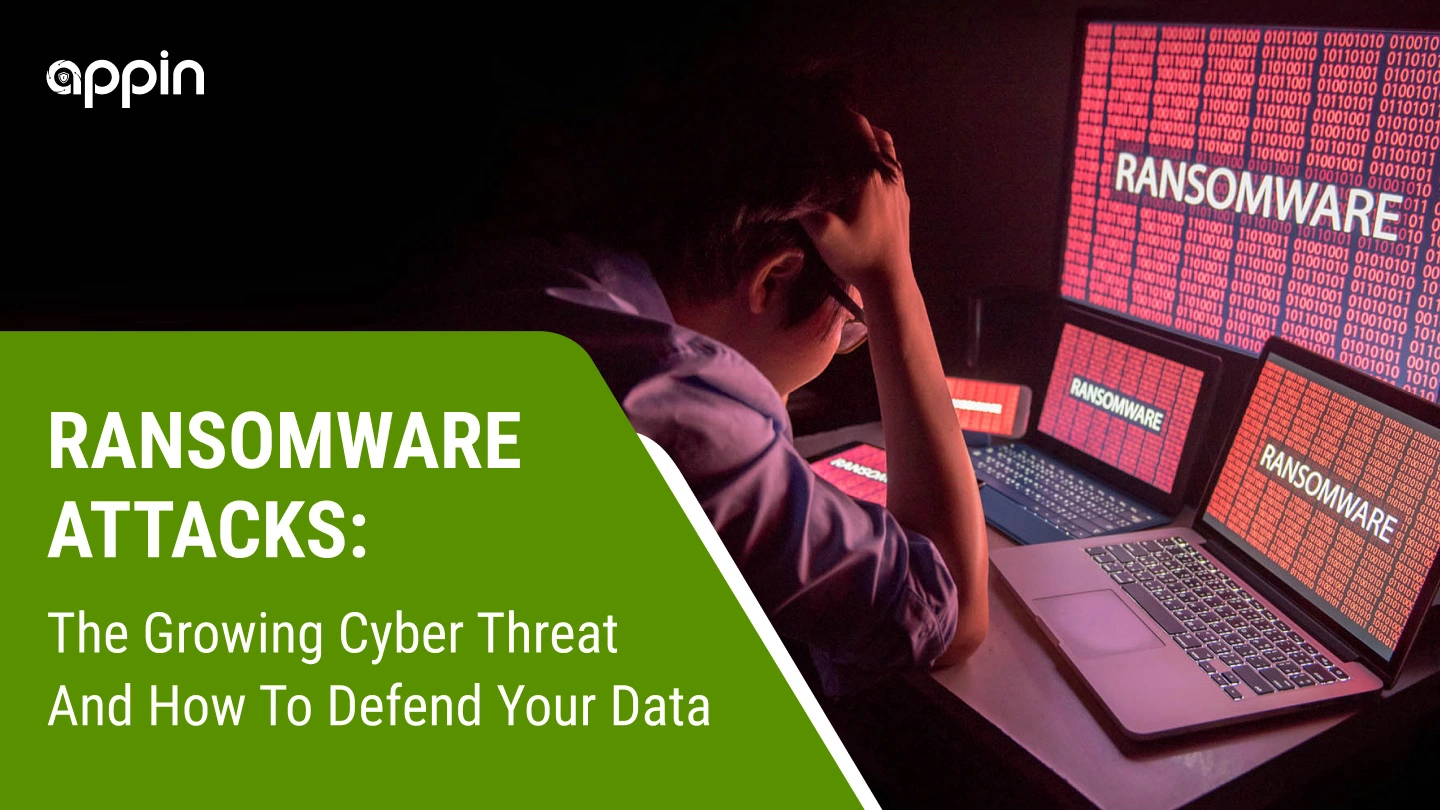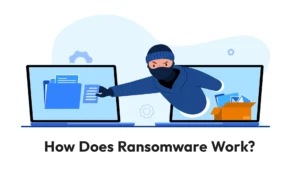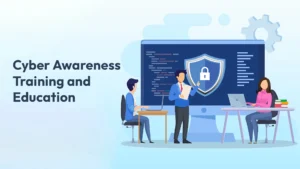Let’s address that’s unfortunately happening a lot – ransomware attacks. They’re like those unwelcome guests crashing the digital party for small and medium-sized businesses.
So, why do hackers like this? It’s like the fast food of cybercrime – quick, easy, and you can buy ransomware tools on the dark web. Not cool, right? To keep your organization and data safe, you’ve got to understand what ransomware is all about.
In this guide, we’ll break down the rising threat of ransomware and give you tips on how to protect your important information from these bad attacks.
What is Ransomware?
Ransomware is a type of malicious software designed to block access to a computer system or files until a sum of money, or ransom, is paid. It’s a form of cyberattack where the attacker encrypts the victim’s data and demands payment for its release. The demand for payment is often made in cryptocurrency to make it harder to trace.
Ransomware attacks can affect individuals, businesses, and even government organizations. It can be delivered through various methods, including phishing emails, malicious attachments, or exploiting vulnerabilities in software and systems.
Preventing ransomware involves robust cybersecurity practices, regular software updates, and user education to recognize and avoid phishing attempts, which are common entry points for these attacks.
Example
Let’s simplify this ransomware thing with an example. Picture yourself at work, going through your emails. Suddenly, you receive an innocent-looking email, maybe from a colleague or a service you use. You click on an attachment, thinking it’s safe, but surprise! Ransomware has just entered your computer.
Now, what does this sneaky software do? It starts locking up all your important files – your top-secret spreadsheets or those funny cat videos you’ve saved. The attacker then sends you a message like, “Hey there, if you ever want to see your files again, send us some cryptocurrency.”
Now you’re stuck, forced to pay these cyber villains to get your stuff back. It’s like having a virtual kidnapper for your data.
How Does Ransomware Work?
Ransomware works by infiltrating a computer or network and encrypting files, making them inaccessible. Here’s a breakdown of how it operates:
- Infiltration: Ransomware gets into your computer or network, often through phishing emails, malicious links, or infected websites. It can also exploit vulnerabilities in software or operating systems.
- Encryption or Locking: There are two main types of ransomware. One type encrypts your files, turning them into unreadable code. The other type locks up your entire device, making it unusable.
- Ransom Demand: After taking your files or locking your device, the ransomware displays a message demanding payment, usually in cryptocurrency. This message threatens to permanently destroy your files or keep your device locked if you don’t pay within a specified time.
- Payment Process: The attackers provide instructions on how to pay the ransom, typically using cryptocurrencies like Bitcoin. They might offer a decryption key (for encrypted files) or a means to unlock your device upon payment.
- Decryption (Sometimes): If you pay and the attackers are true to their word, they may provide a decryption key to unlock your files. However, there’s no guarantee they’ll follow through, and paying doesn’t ensure you won’t be targeted again.
It’s crucial to note that experts generally advise against paying the ransom, as it doesn’t guarantee the return of your files and may encourage more criminal activity. The best defense against ransomware is prevention, including regular backups, updating software, and being cautious with emails and downloads.
Types of ransomware
There are two main kinds of ransomware. The first one, called encrypting ransomware or crypto ransomware, locks up your files by turning them into secret code. The hackers then ask for money in exchange for the key to unlock your files.
The second type, called non-encrypting ransomware or screen-locking ransomware, doesn’t mess with your files but locks up your whole device. Instead of letting you use your computer normally, it shows a screen demanding money to unlock your device.
These two types of ransomware can be further divided into the following subcategories:
- Leakware/Doxware: This type of ransomware steals important information and threatens to share it if you don’t pay up. In the past, it only took the info without locking it, but now it often does both.
- Mobile Ransomware: This affects mobile devices, like phones or tablets. It usually doesn’t lock up your files because mobile devices often have automatic backups. You might get it from bad apps or downloads.
- Wipers/Destructive Ransomware: This one threatens to destroy your data unless you pay. Sometimes, even if you pay, it still wipes out your data. This kind is often linked to big groups or activists, not just regular hackers.
- Scareware: This is ransomware that tries to scare you into paying. It might pretend to be from the police, accusing you of a crime. Or, it could act like a virus alert, telling you to buy special software. Sometimes, it actually locks up your stuff; other times, it’s just a trick to get you to download the real ransomware.
How to Protect Against Ransomware
Being well-prepared can significantly lower the cost and impact of a ransomware attack. Following these best practices can help decrease the risk and minimize the effects on an organization:
Cyber Awareness Training and Education
Ransomware often spreads through phishing emails. It’s essential to train users on recognizing and avoiding potential ransomware attacks.
Many cyber-attacks now begin with targeted emails that don’t necessarily have malware but include a clever message tricking users into clicking on a harmful link. User education is seen as a key defense for organizations against such tactics.
Continuous data backups
Ransomware is a type of malware that forces victims to pay a ransom to regain access to their encrypted data. Having automated and secure data backups is a crucial defense against such attacks.
With regular backups, organizations can recover from an attack with minimal data loss and without paying a ransom. Maintaining routine backups is essential to prevent data loss, whether due to corruption, disk issues, or ransomware attacks.
Functional backups play a vital role in the ability of organizations to recover from the impact of ransomware.
Patching
Keeping software up-to-date through patching is a crucial defense against ransomware attacks. Cybercriminals often search for the newest vulnerabilities in systems, so it’s important to apply the latest patches.
Organizations need to make sure all their systems have the most recent patches, as this minimizes potential weaknesses that attackers could exploit. Regular patching helps enhance the overall security of the business and reduces the risk of falling victim to ransomware.
User Authentication
Ransomware attackers often use stolen user credentials to access services like RDP (Remote Desktop Protocol). Strengthening user authentication makes it more challenging for attackers to utilize guessed or stolen passwords.
It’s advisable to engage a trusted security advisor because ransomware threats are always evolving. A security advisor can provide guidance on best practices, identify effective security controls to mitigate the risk of an attack, and offer assistance in the event of a breach. Having expert advice helps organizations stay ahead of changing threats and enhances their overall cybersecurity posture.
Limit Administrative Privileges
When hackers infiltrate your network, their goal is often to take control of an administrative account. The more users with administrative privileges you have, the greater the opportunity for bad actors to hack into and compromise accounts.
Once they gain administrative control, these malicious actors can navigate more freely throughout your company’s infrastructure, posing a heightened threat to the overall security of your network. Limiting administrative access helps reduce the risk of unauthorized access and potential compromise.
Use Security Software
To significantly decrease the risk of malware infection, it’s crucial to employ security software like endpoint protection, web filtering, and anti-phishing email software.
These tools act as safeguards, helping to identify and block malicious activities, preventing malware from infiltrating your systems. Using a combination of these security measures enhances your overall defense against potential cyber threats and keeps your digital environment more secure.
Conclusion
The rise of ransomware attacks poses a significant and growing cyber threat, especially for individuals and organizations. Understanding the tactics employed by cybercriminals and implementing robust defense strategies is paramount in safeguarding valuable data. From user education and regular patching to the adoption of security software and engaging trusted advisors, a multi-faceted approach is essential.
By staying vigilant, staying informed about evolving threats, and adopting proactive security measures, individuals and organizations can strengthen their defenses against ransomware and better protect their crucial data in today’s dynamic and ever-evolving digital landscape.
As part of these efforts, it’s noteworthy that Appin Technology provides ransomware training to students, equipping them with the knowledge and skills needed to navigate the digital landscape securely. This proactive approach in education contributes to building a more resilient community against the growing threat of ransomware attacks.











